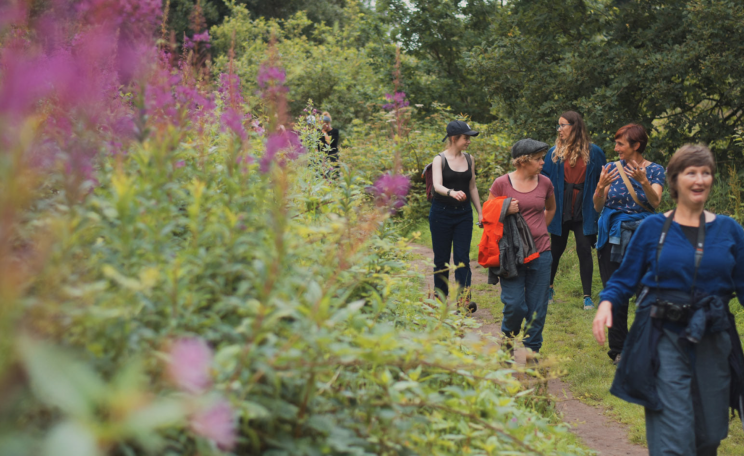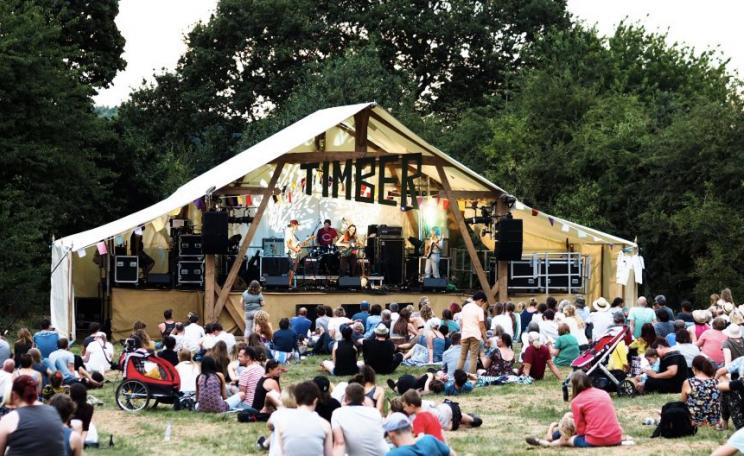-
Timber Festival is three days of music, art and performance to celebrate ‘the transformative impact of forests’.
It is organised by Wild Rumpus and the National Forest Company hosted at Feanedock, in the heart of the National Forest on the Leicestershire/Derbyshire border. This year it was held in (mostly) glorious sunshine on 5–7 July, if you missed it, look out for it next year.
Timber is intended to be an opportunity for ‘nature lovers, day dreamers, big thinkers’ to ‘rethink our relationship with trees and forests’. Whilst rewilding is not exclusively about woodlands, nor even limited to terrestrial habitats, this seemed an ideal location for a public facing panel discussion of rewilding.
Revitalise and expand
Timber's 'Rewilding' panel comprised Ian Convery and Lisa Fenton of the Centre for National Parks and Protected Areas, Andrew Weatherall representing the National School of Forestry, Steve Carver from the Wildland Research Institute and John Everitt, Chief Executive of the National Forest Company (our hosts). The panel was chaired by Brendan Montague, editor of The Ecologist.
The panel commenced with Ian and Steve, co-chairs of the International Union for Conservation of Nature’s Rewilding Task Force, introducing their work developing a rewilding approach that is science-based and community-focussed. Brendan then facilitated the panel discussion with questions from the festival audience.
The debate made it clear that rewilding is a term that has captured the imagination of a wide range of stakeholders, but that it means very different things to different people.
Nonetheless, there appeared to be a broad consensus that rewilding is a concept that presents an opportunity to revitalise and expand the scope of traditional nature conservation approaches.
The aim of this article is not to summarise previous debate, but to continue the discussion by enabling each panel member to expand on a point raised by one of the others.
Ecological restoration
Steve,
I enjoyed the panel and liked Ian’s description of rewilding as “nature led, human enabled” from the IUCN Rewilding Task Force. At the end of the discussion I was particularly intrigued when you switched the words around to describe ecological restoration as “human led, nature enabled”.
As a National School of Forestry lecturer and researcher, I felt this definition suited me. For example, in the restoration of Plantation on Ancient Woodland Sites in the UK, I would start with a National Vegetation Classification survey to determine the most likely naturally occurring community of ground flora and tree species on a site.
Although this should not be an inflexible target, it can guide restoration aims in ‘human led’ management. This might involve fencing to exclude grazing by domestic livestock, the removal of invasive plant species (including exotic conifers that I would still use in commercial plantations elsewhere), culling deer and grey squirrels.
I am not sure how this restoration to Ancient Semi-Natural Woodland fits with rewilding? Would you do these things too? If not, would you be happy with rewilding creating novel ecosystems, which in the UK might contain Sitka spruce, rhododendron, Himalayan balsam, six species of deer and grey squirrels?
Regards,
Andrew
Active vs passive
Thanks Andrew,
I think restoration and rewilding can be allies in the move towards wilder, more natural landscapes that benefit humans andnature. They overlap to varying degrees depending on your approach and objectives.
In your PAWS example, the restoration process starts with quite hands-on management (i.e. fencing, removal of non-native exotics, control of deer etc.), but rewilding takes over once natural processes have established.
At this point as a Forester, you might stand back and allow the processes of natural succession, migration and disturbance to determine how a site develops over longer timescales. Some sites will need greater intervention at an earlier stage depending on the setting.
I’d call this “active” rewilding. The Carrifran Wildwood in the Scottish Borders is a good example. If you start with a more hands-off approach, however, you might end up with the more novel ecosystems you refer to, but the process itself will be nature-led. This is what we might term “passive” rewilding of which Scar Close, the Natural England NNR in the Yorkshire Dales is a good example.
What I’d like to ask Lisa is how she sees these approaches to rewilding fitting in with existing culturally mediated views of land and landscape here in the UK? Is there a greater role for more active rewilding given our desire for definable outcomes and our national obsession with nature “gardening”? How can we get more people onboard, including farmers and the game industry?
Regards,
Steve
Rewilding the self
Steve, Andrew, I see where you are both coming from and these are crucial, big, massively important questions. But my concern is that they are about management, commerce, and engagement with farming and other industries: precisely the agencies which in Marx’s terms, create the alienation from the natural world, and ourselves as natural agents, that Bushcraft seeks to mitigate.
As Kipling tells us, and you remind me, England is a garden, it’s countryside commodified and monetised as a production line: no right to roam as in Sweden, no right to camp, certainly not to fish or trap, or even light a fire.
Small wonder, then, that there are strong ‘backyard Bushcraft’ and stealth-camping movements emerging. But still the idea of a self-sufficient existence in a natural environment persists: look at the popularity of Mick Kitson’s novel Sal, for example, not to mention a plethora of popular main-stream TV productions surrounding aspects of wilderness survival and bushcraft practice.
At present, the UK offers very little in terms of access to wild places, and endorses a ‘hands off’, ‘Leave No Trace’ approach to visiting wild places, which, whilst understandable, nevertheless creates the effect of insulating people from the very natural world with which they may seek to make a direct, personal relationship.
I don’t believe people should just do as they please in the natural world and my professional life has been devoted to teaching Bushcraft, that is, how to develop a deep personal relationship with the natural world through ecological knowledge and skilled practice. But my challenge to you and my question to John is, how do we bring about a habitat that provides the affordances for UK citizens that are enjoyed, for example, in Canada and Scandinavia?
Regards,
Lisa
Crowded island
Thanks Lisa,
I’d love us to enjoy the outdoor freedoms of those other countries. Canada and Scandinavia can adopt a more relaxed relationship with wild spaces partly because they have fewer people – around 4 per km2 and 22 km2 respectively compared to more than 400 people per km2 in England.
This, and a history of land ownership in the UK that has been less equitable and now affords fewer informal greenspaces, commons and accessible sites means we are losing our connections with the natural world.
Add to this the lack of time our young people are spending outdoors, let alone in wild places, and we can see the scale of disconnection. But I am hopeful we can begin to restore these connections as we restore the habitats.
The National Forest is a response to this, 200 square miles of new forested area across the Midlands where 80 percent of the new habitat created has public access so that people can get out into woodlands, and are encouraged to enjoy a woodland culture of harvesting wood fuel, picking fruit from community orchards, engaging in wild play and learning bushcraft skills.
This is not rewilding in the passive sense that Steve described, but it’s at a landscape scale and is involving communities, farmers, landowners and business to reconnect with nature from where they are at. Given time, I think we will see people adopting that ‘deeper connection’ with the landscape that you describe, just as we will see the landscape itself exhibiting more natural processes.
But we’re not reintroducing wolves and wild boar anytime soon to restore ecological function, so my question for Ian is for us to even call this active rewilding, is there a minimum area or level of ecological process that we need to reach?
Regards,
John
Wilderness continuum
Thanks John,
I am going to start by referring to a rewilding article by Gordon Eaglesham recently published in The Ecologist. He refers to ‘protected wilderness areas connected by a network of habitat corridors, reinvigorated by trophic function’.
I think this gets to the heart of the minimum size debate, which can often lead us down a conservation rabbit hole. Clearly it would not be possible, or indeed desirable, to rewild everywhere, and elsewhere Steve and I have talked about the idea of a ‘Wilderness Continuum’ as a way of understanding the degree of naturalness/human modification of landscapes.
So whilst size does matter, the key issue for me is connectivity. It is true that larger areas are inevitably required for rewilding fully functional and self-willed ecosystems complete with predation, competition and other biotic and abiotic interactions, but aspects of wildness can exist even in urbanised and agricultural landscapes.
We can all, therefore, do our bit for rewilding; our farms, gardens, parks and allotments can help provide connectivity within a landscape mosaic of core conservation areas and compatible human land use.
With this in mind, rewilding is as much about ‘rewilding the self’ as Lisa notes above, as it is about restoring ecological function. Given the scale of the biodiversity crisis, we need both societal and ecological transformative change; rewilding offers an opportunity to create much greater engagement with the ecological processes that are essential for life on the planet.
Brendan, over to you to summarise, good luck!...
Regards,
Ian
These Authors
Dr Andrew Weatherall MICFor is a senior lecturer in the National School of Forestry, University of Cumbria. He is programme lead for BSc (Hons) Woodland Ecology and Conservation.
Dr Steve Carver is a senior lecturer in the School of Geography, University of Leeds and Director of the Wildland Research Institute. He is co-chair (along with Ian Convery) of the IUCN CEM Rewilding Task Force.
Dr Lisa Fenton is an ethnobiologist and well-respected Bushcraft practitioner. A lecturer in Outdoor Studies, University of Cumbria, she is the pathway leader for MA Outdoor and Experiential Learning (in Bushcraft).
John Everitt is the chief executive of the National Forest Company responsible for coordinating the National Forest, one of the boldest environmental projects in the country and host to the Timber Festival.
Ian Convery is Professor of Environment and Society at the University of Cumbria and is co-chair (along with Steve Carver) of the IUCN CEM Rewilding Task Force.
Image: Dr Dorthe Villadsen, University of Cumbria.






